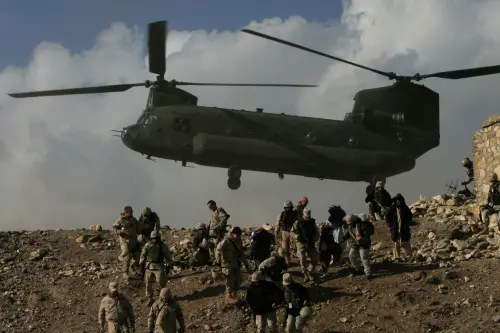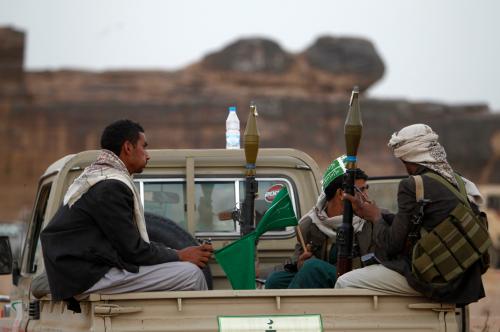“We will not tolerate more genocide of innocent tribesmen.”
This was the message of hundreds of tribesmen from Waziristan demonstrating in front of the Governor’s House in Peshawar, Pakistan on March 5, 2013. They were protesting the on-going drone campaign Pakistan which is almost exclusively targeting their home of Waziristan. Only 18 drone strikes in Pakistan have been outside of the two tribal agencies that comprise the region of Waziristan. These tribesmen were bringing attention to the fact that these drone strikes have traumatized entire tribal communities and resulted in the deaths of many innocent people, including women, children, and the elderly, in traditional meetings of councils of elders, inside mosques, and in residential homes.
As the debate about the drone and the war on terror in America emerges, these are the voices that are not heard—those of the victims and the targeted communities. They are lost in the din of the war on terror and the 24 hour media cycle in the United States. The debate is in fact no debate at all: only one position, that of America, is represented. The arguments swirl around the precision of drone technology, keeping American boots off the ground, and the legality of the strikes. Few are concerned with the moral implications of the drone’s use and the social and historical reasons why certain members of the targeted communities have resorted to violence, being merely cast aside as “Islamic terrorists,” “Islamists,” or “jihadists.”
My latest study with Brookings Press The Thistle and the Drone: How America’s War on Terror Became a Global War on Tribal Islam, the third book in my trilogy on relations between the U.S. and the Muslim world after 9/11, provides the missing part of the debate. The Thistle and the Drone explains an important correlation: the United States uses drones almost exclusively against Muslim tribes with strong codes of honor and revenge living on the borders between nations—the tribes on the border of Afghanistan and Pakistan, in Yemen, Somalia, the southern Philippines, Turkey, and Mali. For these communities, the deadly drone is a symbol for America’s war on terror. It is constantly hovering above unseen, operated by Americans on the other side of the world, and with the ability to strike at will. The thistle is a symbol of these fierce tribes, invoking Leo Tolstoy’s novel Hadji Murad in which he compares the Caucasian tribes battling the advancing Imperial Russian army in the 19th century with this prickly flower.
Many of these tribal communities had been fighting for decades in order to defend their identity, culture, and independence in the chaotic and often brutal modern states created after the departure of the European colonial powers. After the tragic events of 9/11, it was to the “ungoverned spaces” of these peripheral communities that the United States looked to in their hunt for al Qaeda. Many of their central governments found it convenient to ally themselves with the United States and become integrated in the globalized financial, military, information, and communication networks. The United States, dominated by ideas of a “clash of civilizations” between the West and Islam, were quick to ascribe the retaliatory actions of the tribes as the work of al Qaeda or al Qaeda-linked militants as part of a “global jihad.” Once the specter of al Qaeda was invoked, the United States’ was fully committed to bolstering the military capabilities of its allies. U.S. involvement, especially the use of the drone, proved to exacerbate and expand these conflicts, each with their own social and historical context. The war on terror had thus become a global war on tribal Islam.
Amidst the anarchic violence, it is, however, the innocent men, women, and children of the periphery who suffer the most—children in a school, poverty-ridden families standing in line for food, or congregations at worship in a house of prayer. These communities are facing a massive humanitarian crisis yet their plight goes unrecognized under the din of America’s war on terror and the heavy fog of war. Pounded by drones and military strikes one day, suicide bombers the next, the people of the periphery cry out, “Everyday is like 9/11 for us.”
Relying upon forty case studies of tribal societies across the Muslim world, from Morocco to the southern Philippines, The Thistle and the Drone shows that the war on terror across the Muslim world is being fueled by the structural breakdown between the center and periphery rather than any compulsion within the Islamic faith. This study takes the reader into the heart of the war on terror—Waziristan—one of the most battered regions of the world by drones and where I served as the government administrator, or Political Agent, in the late 1970s. Using my own experiences in Waziristan, I describe how traditional tribal society functions and how to effectively administer them as a representative of government authority. I then show how the historical tension between the center and periphery spiraled out of control after 9/11, leading to one of its deadliest manifestation, the Tehrik-e-Taliban Pakistan (TTP) based in the toughest clan of the toughest tribe of the Tribal Areas of Pakistan, the Shabi Khel of the Mahsud.
Expanding to other tribal societies in Central Asia, the Middle East, North Africa, and Eastern Europe, I establish a new frame for understanding the war on terror based in the historical conflict between the central government and tribal periphery, resulting in the mutation of the tribal code and increasingly deadly violence. I even discovered the catalyst for the war on terror—the 9/11 attacks—impossible to fully understand without knowledge of tribal society and this new paradigm for the war on terror. Of the 19 hijackers on 9/11, 18 of them, along with Osama bin Laden himself, were Yemeni tribesmen motivated by tribal codes. Of the 18 Yemeni hijackers, 10 were from the Yemeni tribes of the beleaguered Asir region on the southwest periphery of Saudi Arabia.
After over a decade, it is abundantly clear that the United States has been fighting the wrong war with the wrong methods against the wrong enemy. Only by recognizing the true source of the violence and the nature of the tribal society which produces it can the U.S. begin to provide lasting solutions. The Thistle and the Drone lays down this path to ending and winning the war on terror. In this age of globalization, we must be guided by the shibboleth tikkun olam—to go out and “heal a fractured world.” Peace is in everyone’s best interests.
The Brookings Institution is committed to quality, independence, and impact.
We are supported by a diverse array of funders. In line with our values and policies, each Brookings publication represents the sole views of its author(s).



Commentary
The Thistle and the Drone: The United States, Islam, and the War on Terror
March 7, 2013